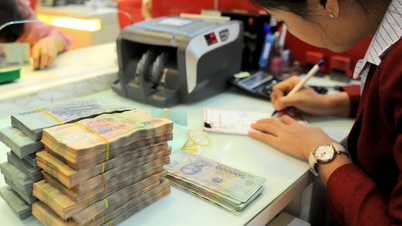The central exchange rate increased by 24 VND, the VN-Index increased by 18.02 points compared to the previous weekend, or the State Bank of Vietnam withdrew a net 69,699.9 billion VND from the market... are some notable economic news in the week from March 18-22.
| Economic news review March 20 Economic news review March 21 |
 |
| Economic information review |
Overview
Several major central banks around the world have important monetary policy meetings in March. The policy moves of these central banks are mixed due to the specific context of each country and economic region, most notably the meetings of the US Federal Reserve (Fed) and the Bank of Japan (BoJ). However, it can be predicted that policy rate cuts will be the main trend in the world in 2024.
The Fed raised its economic and inflation outlook for 2024, but did not change its forecast for cutting policy rates. Specifically, in the two-day meeting on March 19-20, the Fed raised its US economic outlook for 2024 to 2.1%, much more positive than the 1.4% forecast in December 2023. The core PCE price index for the end of 2024 was also raised by this agency to 2.6% from 2.4% in the previous forecast.
In addition, the US labor market has also been steadily creating new non- agricultural jobs in recent months. The Fed forecasts the unemployment rate in the US at the end of the year at only 4.0%, slightly lower than the previous forecast of 4.1%. The above forecasts show that the US economy is really under pressure from the high interest rate environment and is likely to have a soft landing when inflation moves towards the target and the Fed cuts policy interest rates again.
Regarding monetary policy, in the recent meeting, the Fed maintained its forecast that the policy interest rate at the end of 2024 will stand at around 4.6% (ie in the range of 4.5% - 4.75%), down 75 basis points from the current level of 5.25% - 5.50%, unchanged from the previous forecast.
Fed Chairman Jerome Powell also said after the meeting that the agency has made great strides in controlling inflation, but the road ahead is still "bumpy". More importantly, he said that policy interest rates are likely to have peaked and that a cut in policy interest rates this year is reasonable.
In contrast to the Fed's move, the BoJ raised its policy interest rate for the first time in 17 years. At its meeting last week, on March 19, the BoJ said that inflation in Japan could steadily rise above 2.0% in 2024. Data showed that the country's headline CPI had actually exceeded the 2.0% threshold for more than a year. In addition, in recent wage negotiations, major companies in Japan also agreed to raise wages for workers to the highest level in 33 years.
The above factors are the main reasons why the BOJ decided to raise the policy interest rate to 0.1% from -0.1% applied since the beginning of 2016. This is also the first time the BoJ can raise the policy interest rate again in 17 years.
In addition, the BoJ also proceeded to narrow and eventually end its quantitative easing (QE) measures within the next year. Further reinforcing the BoJ's view, in its report on March 22, the Japanese Government said that the country's GDP increased slightly by 0.1% in the fourth quarter of 2023, contrary to the forecast of a slight decrease of 0.1%.
Officials say the economy is growing at a moderate pace, and hope wage growth will keep consumer demand (which accounts for 50% of GDP) improving despite the BoJ's slight interest rate hike.
The European Central Bank (ECB), the Bank of England (BoE) and the Reserve Bank of Australia (RBA) all temporarily maintained a cautious stance. These central banks also held monetary policy meetings in March, leaving their policy rates unchanged at 4.75%, 5.25% and 4.35% respectively, while waiting for further data on inflation and the economy to decide their next move.
GDP of all three regions showed very weak signs in the last quarter of 2023, respectively flat, down -0.3% and slightly up 0.2% compared to the previous quarter. Inflation also showed signs of cooling down more quickly, increasing only 2.6%, 3.3% and 3.4% respectively compared to the same period last February, not too far from the 2.0% inflation target that all three central banks are pursuing.
In general, except for the US and Japan, other developed economies are facing the same situation of weak growth and gradually cooling inflation over time. The ECB, BoE and RBA are all under pressure to cut policy rates if they want to support economic recovery. The problem for these central banks now is just the right time to act, avoiding the risk of inflationary pressure rising again. Accordingly, the time when the Fed cuts policy rates (most likely June 2024) will be very important (although it may come after the ECB, BoE and RBA), marking the world's monetary policy entering a broad reversal phase.
Domestic market summary week 18-22/3
In the foreign exchange market during the week of March 18-22, the central exchange rate was adjusted by the State Bank in an upward trend. At the end of March 22, the central exchange rate was listed at 24,003 VND/USD, an increase of 24 VND compared to the previous weekend session.
The State Bank of Vietnam's exchange office continued to list the buying rate at 23,400 VND/USD, while the USD selling price at the end of the week was listed at 25,153 VND/USD, 50 VND lower than the ceiling rate.
The interbank USD-VND exchange rate during the week of March 18-22 continued to increase gradually through most sessions. At the end of the session on March 22, the interbank exchange rate closed at 24,770 VND/USD, up 50 VND compared to the session at the end of the previous week.
The USD-VND exchange rate on the free market fluctuated between increases and decreases last week. At the end of the session on March 22, the free exchange rate decreased by 103 VND in both buying and selling directions compared to the previous weekend session, trading at 25,457 VND/USD and 25,537 VND/USD.
In the interbank money market during the week of March 18-22, interbank VND interest rates fell sharply across all terms. Closing on March 22, interbank VND interest rates were trading around: overnight 0.20% (-0.66 percentage points); 1 week 0.48% (-0.61 percentage points); 2 weeks 1.20% (-0.24 percentage points); 1 month 1.76% (-0.28 percentage points).
Interbank USD interest rates remained almost unchanged across all terms. On March 22, the interbank USD interest rate closed at: overnight 5.21% (+0.01 percentage point); 1 week 5.30% (unchanged); 2 weeks 5.38% (+0.01 percentage point) and 1 month 5.40% (unchanged).
In the open market week of March 18-22, in the mortgage channel, the State Bank offered 7-day term with a volume of VND15,000 billion, interest rate at 4.0%. There was no winning volume, no circulating volume on this channel.
Last week, the State Bank of Vietnam (SBV) offered 28-day SBV bills for auction, bidding on interest rates in all sessions. At the end of the week, a total of VND69,699.9 billion was won, the interest rate decreased from 1.4%/year to 1.35% and then 1.32% in the following sessions, and increased to 1.7% at the end of the week.
Thus, the State Bank of Vietnam (SBV) withdrew a net VND69,699.9 billion from the market last week through the open market channel, the volume of SBV bills in circulation stood at VND144,698.8 billion.
On March 20, the State Treasury successfully mobilized VND6,095 billion/VND13,500 billion of government bonds offered for auction, equivalent to a winning rate of 45%. Of which, the 10-year term successfully mobilized VND3,095 billion/VND5,000 billion offered for auction and the 15-year term mobilized VND3,000 billion/VND5,000 billion offered for auction. The 5-year and 30-year terms were offered for auction at VND3,000 billion and VND500 billion, respectively, but the auctions failed. The winning interest rate for the 10-year term was 2.39% (+0.03 percentage points compared to the previous auction), and for the 15-year term was 2.59% (+0.03 percentage points).
This week, on March 27, the State Treasury offered VND13,000 billion in government bonds, of which the 5-year term offered VND1,000 billion, the 7-year term offered VND2,000 billion, the 10-year term offered VND5,000 billion, the 15-year term offered VND4,500 billion and the 30-year offered VND500 billion.
The average value of Outright and Repos transactions in the secondary market last week reached VND9,062 billion/session, up from VND8,815 billion/session the previous week. Government bond yields last week continued to increase across all maturities.
At the close of the session on March 22, government bond yields were trading around 1 year 1.39% (+0.06 percentage point compared to the previous session); 2 years 1.41% (+0.05 percentage point); 3 years 1.46% (+0.06 percentage point); 5 years 1.67% (+0.03 percentage point); 7 years 2.05% (+0.04 percentage point); 10 years 2.54% (+0.01 percentage point); 15 years 2.74% (+0.03 percentage point); 30 years 3.04% (+0.02 percentage point).
The stock market in the week of March 18-22, similar to the previous week, the stock market adjusted strongly in the first session of the week but recovered positively afterwards. At the end of the session on March 22, VN-Index stood at 1,281.80 points, up 18.02 points (+1.43%) compared to the end of the previous week; HNX-Index increased by 1.14 points (+0.89%) to 241.68 points; UPCoM-Index decreased slightly by 0.40 points (-0.44%) to 90.95 points.
Market liquidity was at a very high level, averaging VND33,000 billion/session, a positive increase from VND27,500 billion/session the previous week. Foreign investors continued to net sell nearly VND2,600 billion on all three exchanges.
International news
The US recorded some notable economic information. First, in the construction sector, the number of housing permits and housing starts in the US recorded 1.52 million and 1.52 million units respectively in February, higher than 1.49 million and 1.37 million in January, and also higher than the expected 1.50 million and 1.43 million units.
In addition, sales of old houses in this market reached 4.38 million units in February, a sharp increase compared to the 4.0 million in January and at the same time higher than the forecast of 3.95 million units. This is the month with the highest sales level since March 2023.
Next, the S&P Global survey said the US manufacturing PMI reached 52.5 points in March, up slightly from 52.2 points in February and at the same time higher than the forecast of 51.8 points. In contrast, the service sector PMI this month only reached 51.7 points, down from 52.3 points in February, lower than the forecast of 52.0 points.
In the labor market, the number of initial unemployment claims in the US in the week ending March 16 was 210 thousand, contrary to the forecast of 212 thousand as the statistical results of the previous week. The average number of claims in the last 4 weeks was 211.25 thousand, a slight increase of 2.5 thousand compared to the average of the previous 4 weeks.
Finally, the US current account deficit was $195 billion in the last quarter of 2023, almost equal to the previous quarter's $196 billion deficit, but still slightly lower than the forecast $209 billion deficit. This week, the market continues to wait for the official report on US GDP in the fourth quarter of 2023 and the core PCE consumer price index in February 2024, which will be announced on the evening of March 28 and 29, respectively, Vietnam time.
The BoE left its policy rate unchanged at its March meeting, while the UK economy also received some important indicators. At its meeting on March 21, the BoE forecast that headline CPI would fall slightly below the 2.0% target in the second quarter of 2024 before rising slightly in the third and fourth quarters.
The MPC decided to maintain the policy rate at 5.25%, unchanged from the previous level, while maintaining the view that the tight monetary policy should be maintained for a sufficient period until the risk of inflation exceeding the 2.0% target is eliminated. The MPC will continue to closely monitor signs of inflationary pressures and the economic recovery to make further decisions.
Regarding the UK economy, the headline CPI and core CPI in the country increased by 3.4% and 4.5% year-on-year respectively in February, decelerating significantly compared to the previous month's 4.0% and 5.1%, nearly matching the forecast of 3.5% and 4.6%.
Next, UK retail sales were flat in February (0.0% m/m) after rising 3.6% m/m in January, against forecasts for a slight decline of 0.4%. Compared to the same period in 2023, UK retail sales fell slightly by 0.4% m/m.
Finally, S&P Global said the UK manufacturing PMI came in at 49.9 in March, up from 47.5 in the previous month and beating expectations of 47.9. The UK services PMI recorded 53.4 this month, against forecasts of 53.8 in February.
Source link







































![[Photo] Binh Trieu 1 Bridge has been completed, raised by 1.1m, and will open to traffic at the end of November.](https://vphoto.vietnam.vn/thumb/1200x675/vietnam/resource/IMAGE/2025/10/2/a6549e2a3b5848a1ba76a1ded6141fae)

































































Comment (0)